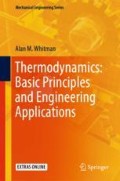Abstract
In our study till now, we established the first law of thermodynamics, in which we saw that heat and work are equivalent insofar as they are different manifestations of the energy exchange between a system and its surroundings (or between various parts of a system). However, in this development, an asymmetry between heat and work has remained.
Access this chapter
Tax calculation will be finalised at checkout
Purchases are for personal use only
Notes
- 1.
Newton’s law of Universal Gravitation, Eq. (1.25), is a prime example. The introduction of a “force of gravity”, that acted over enormous reaches of empty space, together with the law of motion, Eq. (1.26), not only gave a quantitative description of celestial motion, but also showed how the planetary orbits were related to the motion of projectiles in the vicinity of the earth.
- 2.
Because of what will follow we need to specify here which variable is held constant in the partial differentiation.
- 3.
Note the difference between \(\partial _Ts|_p=c_p/T\) and \(\partial _Ts|_v=c_v/T\), which is why we must distinguish between them.
- 4.
The form \(s=\tilde{s}(p, v)\) is especially useful in piston-cylinder problems. The last two (of the four) Maxwell relations equate its partial derivatives, \(\partial _ps|_v\), and \(\partial _vs|_p\) to measurable quantities.
- 5.
- 6.
Corollary 5.9 was adopted by both William Thomson (Lord Kelvin) and Max Plank as an Axiom together with a variant of Axiom 5.1, and used to develop the second law and all of its consequences. It is known as the Kelvin–Plank statement of the second law of thermodynamics.
Author information
Authors and Affiliations
Corresponding author
Rights and permissions
Copyright information
© 2020 Springer Nature Switzerland AG
About this chapter
Cite this chapter
Whitman, A.M. (2020). The Second Law. In: Thermodynamics: Basic Principles and Engineering Applications. Mechanical Engineering Series. Springer, Cham. https://doi.org/10.1007/978-3-030-25221-2_5
Download citation
DOI: https://doi.org/10.1007/978-3-030-25221-2_5
Published:
Publisher Name: Springer, Cham
Print ISBN: 978-3-030-25220-5
Online ISBN: 978-3-030-25221-2
eBook Packages: EngineeringEngineering (R0)

